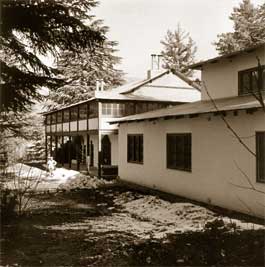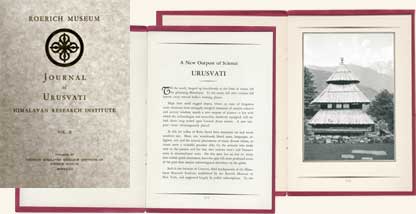| printer friendly | |||
|
|||
 | |
| The administrative and medical buildings
of the Institute of Himalayan Studies “Urusvati”. 1930s |
On the mountain slope, a little higher that the Roerichs’ house, two buildings of the Institute of Himalayan studies are situated.
The Institute was called “Urusvati”, what means “The Light of the Morning Star”. “Is it not the morning, glorious for new labor and achievements, N. Roerich wrote, that is everlasting cure, everlasting search, everlasting achievement? In these areas, where great wisdom of Rig-Vedas was crystallized, where Mahatmas themselves passed, here, in the caves and on the tops, the power of the human thought was accumulated! <…> This is a unique place for many scientific studies. Here you feel the feast of knowledge and beauty”4.
In the show-case in front of us, there is a photograph of the administrative and laboratory buildings of the Institute. And here is the photograph of G. Roerich, who was chosen to be the Institute director and was its leading worker.
The “Urusvaty” Institute was a complex one, various sciences were represented in it. Beside the archeological department, departments of natural sciences and Tibetan medicine, history of Asian peoples’ culture, philology, were opened under the Institute. There was a library and a museum there. Astronomy and astrophysics, biology and chemistry were studied in the Institute. Laboratory for study of medications against cancer was being created, a free clinic for local population was opened.
In beautifully equipped laboratories, a complex of studies of human psychic energy, the energy of thought, was planned. “Thought, as subtlest energy, is the base of the Subtle World <…> Everything there is created by the thought, and the thought destroys everything too”5, Nicholas Roerich wrote. “<…> we know that for researches in the field of thought, serious scientists got into all kinds of administrative trouble, and sometimes even lost positions at the University departments. It happened both in Europe and America. But evolution develops beyond any human bolts and blames. <…> everywhere, in place of recent negations and mockery, new boundless knowledge appears”6.
There had not yet been institutes like “Urusvati” in the world. It was as if ahead of its time. Ancient knowledge was combined in its activities with recent scientific discoveries. It united in an amazing way traditional methods of ancient Asia and those that only were to be formed.
In winter, the Institute employees worked in laboratories, and in summer they set out on scientific expeditions. Here, in the stony soil of Himalayan valleys, nobody had ever performed archeological excavations. Nicholas Roerich was convinced that excavations would confirm what the Central-Asian expedition gave to him. He was sure that there, in the Himalayas and India, there were many solutions for the secrets of the ancient culture of mankind. The great travel continued, and the Institute constituted its integral part.
 | |
| Magazines of the Institute of Himalayan Studies “Urusvati”.
New York. 1931 – 1933 |
“The station must develop into a city of Knowledge, Helena Roerich wrote about the Institute. – We wish to secure a synthesis of scientific achievements in this city. That is why all fields of science must be represented in it afterwards. And as knowledge has the whole Cosmos as its source, the scientific station participants must belong to the whole world, that is to all nations <…>”7.
All the family members took part in the Institute activities. H. Roerich, subtle expert of art, unique philosopher, thinker, was its Honorary President.
Svetoslav Roerich, painter, expert in ancient art and local pharmacopoeia, good botanic and ornithologist, took up natural sciences.
George Roerich, the Institute Director, Orientalist, archeologist, linguist, together with learned lamas, worked on creation of a Tibetan-Sanskrit-Russian-English dictionary and formed a most precious collection of ancient Tibetan manuscripts and books. He was the first to undertake a number of archeological excavations in Kullu and adjacent areas of Indian Himalayas. His studies publications were important events in the scientific world.
 | |
| N. Roerich, H. Roerich, G. Roerich, S. Roerich
in the valley of Kullu |
Tibetan lamas and Indian scientists took part in the Institute work. Major scientists of the West, including A. Einstein, collaborated with the Institute. Academician N. Vavilov, famous biologist and geneticist, exchanged letters with the “Urusvati” Institute. The scientist was studying the origin of cultivated plants, and his searches brought him to the Himalayas. Parcels with samples and seeds of needed by him plants were forwarded to Vavilov from “Urusvati”. Nicholas Roerich and Nikolai Vavilov dreamed of a personal meeting, but that meeting never took place…
“The Light of the Morning Star”, which flashed up in 1928 in remote Himalayas, for a short moment lit the path of those who searched and strived. In 1939, the Second World War started. The work in the Institute was suspended. “Today, it has been a quarter of a century of our wanderings, Roerich wrote in 1942. – Each of the four of us has accumulated considerable knowledge and experience in his field. But for whom have we all worked? Can it be that we have worked for strangers? Of course, for our, for the Russian people we have had happy moments, and hardships, and dangers. In many spheres we have managed to contribute the true understanding of Russian searches and achievements. Not for a second did we deviate from the Russian ways. It is nobody but Russians who can move along our Asian paths”9.
|
|
||
|
||
